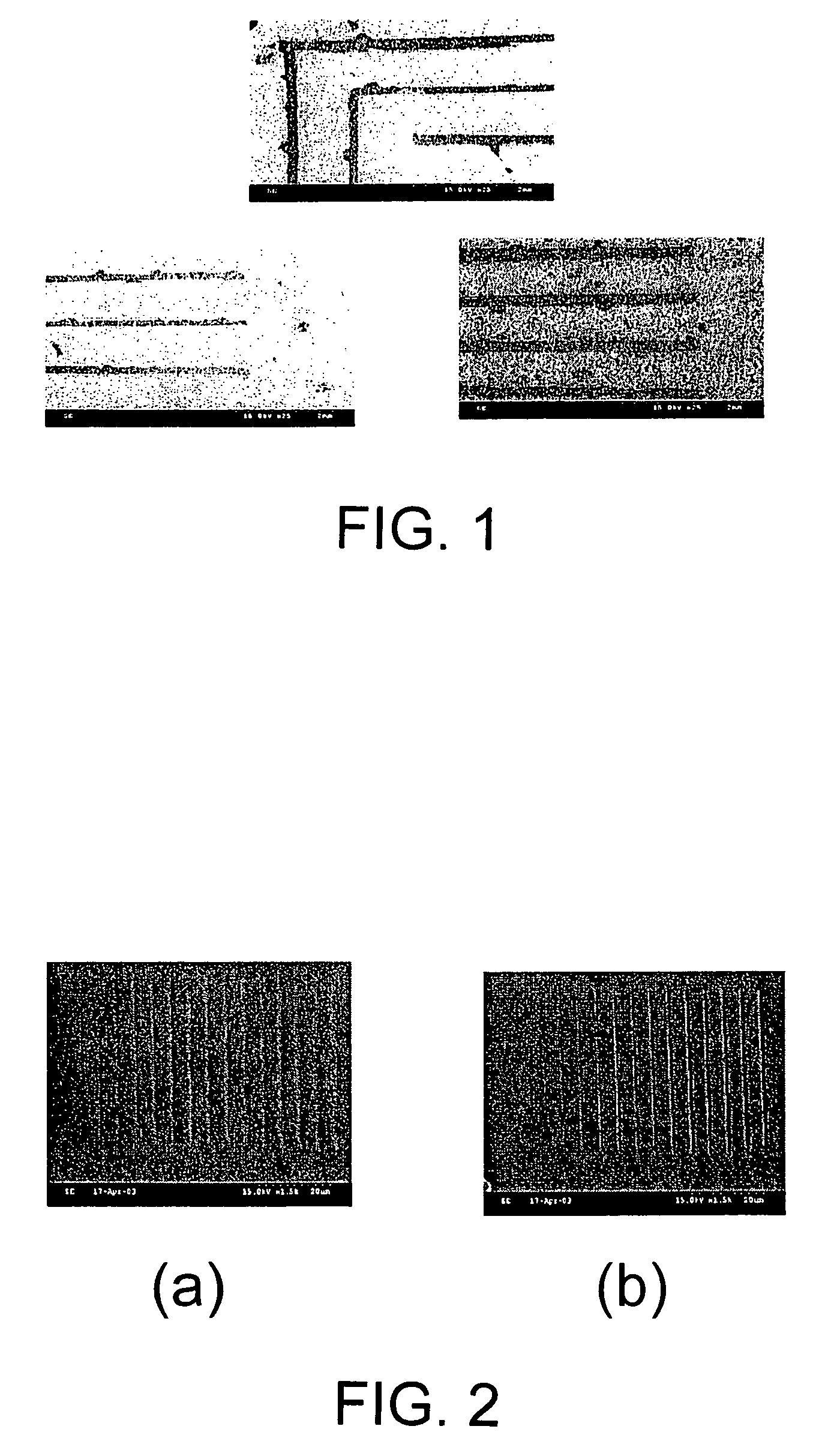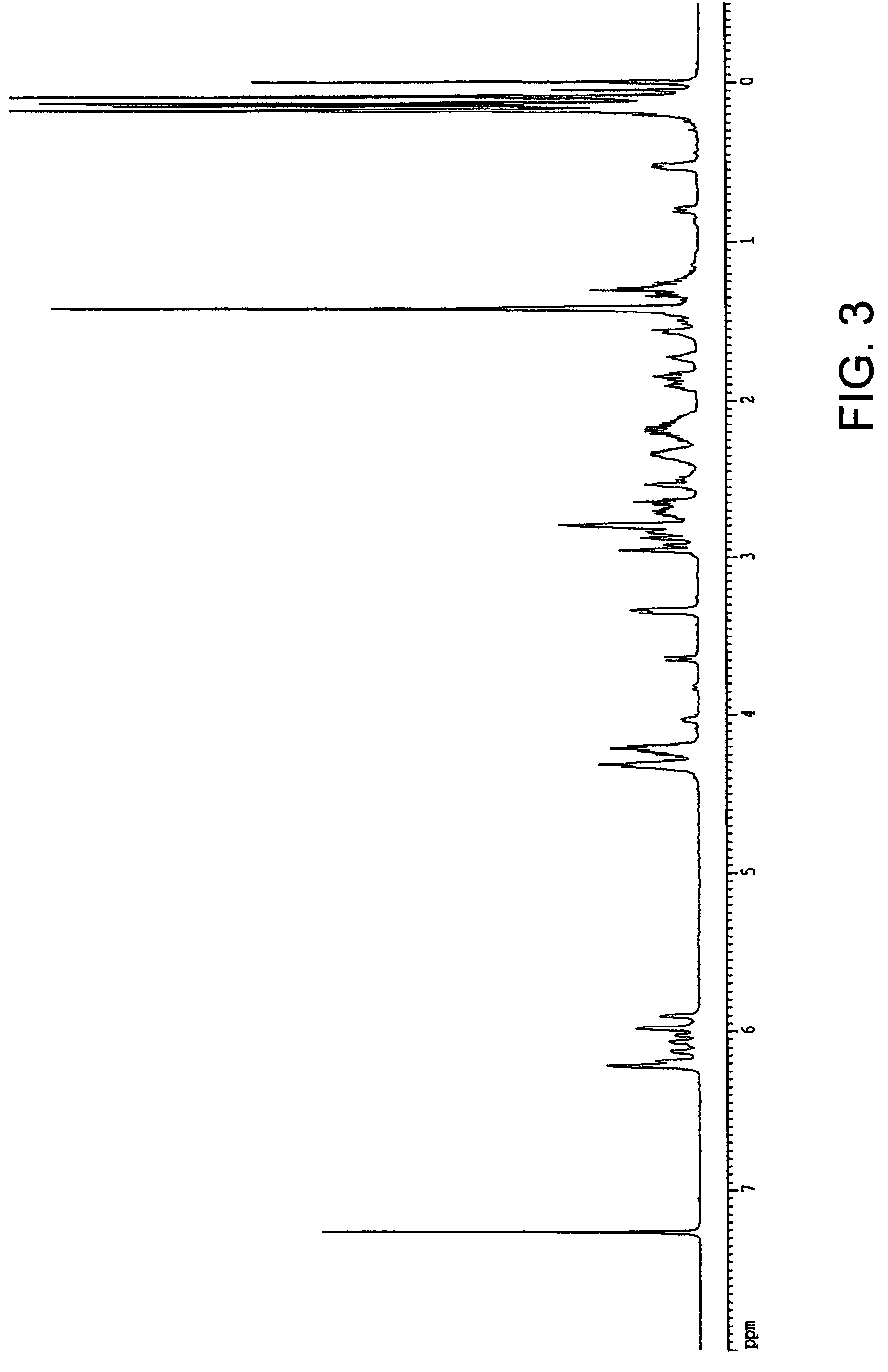Norbornene-type monomers and polymers containing pendent lactone or sultone groups
a technology of pendent lactone or sultone group and monomer, which is applied in the direction of photosensitive materials, instruments, photomechanical equipment, etc., can solve the problems of resist material erosion during the subsequent dry etching process, polymer is not developable, etc., and achieves high etch resistance, easy cleavage of acid labile protection, and high transparency
- Summary
- Abstract
- Description
- Claims
- Application Information
AI Technical Summary
Benefits of technology
Problems solved by technology
Method used
Image
Examples
example 1
[0092]
[0093]Synthesis of hydroxyl containing sultone norbornene monomer(HO-Sul-NB): In a 3-neck 250 mL round bottom flask equipped with a mechanical stirrer and a thermometer, 1, 4-butane sultone (27.2 g, 0.20 mol) was dissolved in anhydrous tetrahydrofuran, THF (150 mL). To the solution at −70 C, n-Butyl Lithium 10M in hexane (21.0 mL, 0.21 mol) was added drop wise, followed by the slow addition of 5-norbornene-2-carboxaldehyde (24.4 g, 0.20 mol) by syringe. The reaction mixture was stirred overnight allowing the temperature to rise to ambient. It was worked up by pouring the reaction mixture into water. The organic extracted into an ethyl acetate solution was washed with water then dried over the MgSO4. After removal of solvents by rota-evaporation, the crude product was purified by crystallization in ethyl acetate to give 21 g, 40.6% yield. NMR showed the endo / exo isomers ratio is 89 / 11. For one major endo isomer 1H NMR (500 MHz in CDCl3): 6.20 (dd, 1H), 6.04 (dd, 1H), 4.47 (m, 2...
example 2
[0094]
[0095]Synthesis of hydroxyl containing lactone norbornene monomer (HO-Lac-NB): In a 100 mL, 3-neck round bottom flask equipped with a magnetic stirrer and a thermometer, γ-butyrolactone (5.0 g, 57.5 mmol) in 50 mL of anhydrous THF at −70 C was treated with lithium diisopropylamide, LDA. LDA (2M in THF) (29 mL, 58 mmol) was syringed into the agitating lactone solution cautiously to maintain the reaction temperature 1H (500 MHz in CDCl3): 6.16 (dd, 1H), 6.04 (dd, 1H), 4.38 (m, 1H), 4.19 (m, 1H), 3.12 (s, 1H), 3.08 (m, 1H), 2.83 (m, 1H), 2.60–2.61 (2Hs), 2.31 (m, 1H), 2.22 (m, 1H), 1.87 (s, 1H), 1.44 (d, 1H), 1.26 (d, 1H), 0.56 (dd, 1H); 13C (125 MHz, in CDCl3) 178.68, 137.67, 132.50, 75.94, 67.22, 48.99 44.32, 44.30, 43.76, 42.65, 30.02, 27.20. FI-MS m / e 208.
example 3
[0096]
[0097]Synthesis of TMS protected hydroxyl containing lactone norbornene (TMSO-Lac-NB) monomer: In a 250 mL 3-neck flask equipped with a magnetic stirrer and thermometer, butyrolactone (5.0 g, 57.5 mmol) in 60 mL of anhydrous terahydrofuran at −60 C was treated with 29 mL of LDA (2M in THF). The addition speed of LDA was controlled in order for a reaction temperature lower than −55 C. After added with LDA, the reaction mixture was stirred for 5 min at −55 C. Then it was cooled to −70 C. The dry ice / acetone bath was removed allowing the mixture to warm to −60 C to which 5-norbornene-2-carboxaldehyde (7.0 g, 57.5 mmol) was added via syringe. The reaction mixture was slowly warmed to −55 C and recooled to −70 C by merging the flask into a dry ice / acetone bath. After slowly warmed to −55 C, the reaction mixture was recooled to −60 C and trimethylsilyl chloride (6.6 g, 63.3 mmol) was syringed in. The dry ice bath was removed allowing the reaction temperature to rise to ambient while...
PUM
| Property | Measurement | Unit |
|---|---|---|
| wavelength | aaaaa | aaaaa |
| wavelength | aaaaa | aaaaa |
| wave length | aaaaa | aaaaa |
Abstract
Description
Claims
Application Information
 Login to View More
Login to View More - R&D
- Intellectual Property
- Life Sciences
- Materials
- Tech Scout
- Unparalleled Data Quality
- Higher Quality Content
- 60% Fewer Hallucinations
Browse by: Latest US Patents, China's latest patents, Technical Efficacy Thesaurus, Application Domain, Technology Topic, Popular Technical Reports.
© 2025 PatSnap. All rights reserved.Legal|Privacy policy|Modern Slavery Act Transparency Statement|Sitemap|About US| Contact US: help@patsnap.com



